Guy Campbell, in partnership with his wife Nichole and parents John and Barbara run a multi-generational, mixed farming and grazing enterprise in the Condamine district. Their vision is to stock a pure Angus herd of 1,000 to 1,200 head and breed progeny with high marbling and weight gain for the feeder market.
 Managing 26,750 acres over six properties, including a lease property of 3,700 acres, the Campbell family currently run 1,000 breeders and farm 4,500 acres, producing both grain and fodder crops.
Managing 26,750 acres over six properties, including a lease property of 3,700 acres, the Campbell family currently run 1,000 breeders and farm 4,500 acres, producing both grain and fodder crops.
Originally running a Bos taurus cow herd joined to European breed bulls, the transition to Angus started nine years ago. Although the hybrid vigour from their crossbred calves is something that John and Guy felt that they really benefited from, calving difficulty and the growing premium for Angus saw John purchase a couple of hundred head of straight bred Angus heifers. From there, the marketability, premiums and level of data underpinning accurate breeding values drove the decision to progress to a 100% pure bred Angus herd.
The recent drought hastened the process, with the last of the original Bos taurus cross breeders sold during that period. The Campbells made the decision to feed their Angus breeders at the onset of the drought and have now recovered breeder numbers reasonably quickly, selling down to 800 head and retaining 200 replacement heifers who are due to calve this year (2021).
“We had 1,200 breeders before the drought and we are aiming to get back to that number and potentially a few more now we’ve taken on a bit more country, so we’re rapidly trying to retain heifers” says Guy.
“We’re also at the stage now where we can tidy up the herd a bit with white bellies and things like that to better meet feedlot requirements” adds John.
The breeders are run on a number of the properties in herds of 80-100 head. John explains that they prefer smaller mob sizes as it suits their paddock sizes and the fewer bulls in each paddock reduces injury from fighting.
The Campbells opt to join year-round, replacing the bulls in each herd with fresh bulls every three to four months and are achieving calving rates (percentage of calves weaned from breeder run, annually) of 89% and higher more recently in their younger heifer herds. The birth of progeny year-round gives the business consistent cash flow and the continuity of supply to market cattle during periods of the year when cattle supply is generally tight.
“The saleability of Angus year-round suits our production cycle. Because we are breeding year-round, we have turn off all the time and we can put animals on the market any time of year and sell them. Particularly when there are a lot of animals coming on the market, such as when they come off the oats, there is always buyer demand for black cattle” explains Guy.
From a bull management perspective, the exchange of bulls mitigates the risk of breakdowns and bulls are spelled for a number of months before being re-introduced to another herd. The changeover of bulls is tied in with other husbandry requirements such as 7-in-1 booster shots and backlining for the breeders. Branding and weaning are also done during these quarterly windows.
Weaners are weaned onto fodder crops such as oats on Barramournie and Ashby – predominantly cropping country, typically planted down to 50% grain crop and 50% fodder crop. Replacement heifers are usually picked on type, size, temperament and Angus content – any with white on them are culled – and grown out to 300-350kg. Once they have reach desired weight they are joined as yearlings to high calving ease, low –birth weight bulls, join the breeder herd and must calve unassisted. As a result of the planned expansion in breeder numbers, and the current cattle market, the Campbells are joining all heifers and selling any culls as preg-tested in calf.
Typically, their weaner steers and cull heifers are fed on fodder and turned off by two years of age as milk toothed animals, weighing a maximum of 420kg and ideally having gained 1.2kg/day.
“We are central to many of the big feedlots here and they have all expanded their capacity in recent years. We are really well placed as there is going to be larger requirement for grain and cattle for those feedlots. We normally list our cattle on Auctions Plus and they usually sell locally” says John.
Their cattle’s performance in the feedlot is a prime objective for the Campbells.
“We’re trying to aim for high marbling and good performance in the 400-600 day weight range. We’re finding feedlots have so much data on your cattle that if you keep producing an article that they make money on at their end, they’re going to be coming back to you with a premium because they know your cattle can perform and that’s the relationship we want” says Guy.
To achieve these objectives, Guy identifies suitable bulls using the ‘search catalogues’ function on the angus.tech platform.
“By using the angus.tech platform, we put our parameters on key estimated breeding values (EBVs) in and cull each catalogue down to 20 or so bulls that hit our specs” explains Guy.
“We’re aiming to buy bulls with IMF over +2.5, EMA over +5.0 and try to get 400-day weight over +100kg. Then we play with calving ease according to what we need him for, cows or heifers, but we’re finding that by using the Angus breed, we can get those numbers and good growth rates as well as a low birth weight, you can find the curve bending bulls. We really like the data that Angus has compared to other breeds and the accuracy of EBVs. We like buying bulls on figures and having the confidence in the genetics that bull delivers” says Guy.
From there the bulls are inspected physically and dropped from consideration based on temperament, muscling and structure. The Campbells prefer buying bulls that are aren’t in too forward of a condition and purchase 18-month-old bulls or older, as they don’t require the care younger bulls do. Being repeat clients is also of value to John and Guy, as they see the potential of a bull’s genetics realised at home in the paddock and have that knowledge going into a sale.
More recently, mature cow weight has also become a focus for the Campbells operation. Given their experience during the drought, they value productive cows that aren’t consuming as much to fulfil maintenance requirements and as such, they are keen to moderate their mature cow weight.
“Given that we are chasing growth, we are conscious of the need to keep our mature cow weights down. When you’re feeding animal in drought conditions, you don’t want a bigger cow that’s consuming so much to meet her needs, they are the ones that die or don’t cycle in a drought” says Guy.
In terms of acclimatisation, Guy and John agree that managing mustering in times of heat is important.
“Moving the cattle during hot temperatures is something we work to avoid. We tend to get up at the crack of dawn and get them into the yard by 10am to manage their heat” say John.
Buffalo fly and pink eye are also issues the Campbells have from time to time which they treat for using backliners and eye patches, respectively.
Going forward, it is Guy’s goal to continue to develop the fodder available to support the production system they have in place, with the next development being the establishment of 160ha of Leucaena.
“A part of my dream is to have green feed year-round, so trying to get Leucaena going, in conjunction with our oats and forage, will fill a bit of that gap. Some of the paddocks we have selected for Leucaena have had badly affected by erosion and this will provide full-time soil cover and a bit more soil structure and stability” says Guy.
The Campbell’s selection emphasis on traits vital to their target market is bound to be a major factor in their success. However, it is the consideration of calving ease and maternal traits, such as birth weight and mature cow weight – and the identification of suitable curve bending bulls – that will ensure that their breeding herd continues to produce the article so sought after by buyers, all while suiting the production environment.
Angus Australia acknowledges the funds provided by the Australian Government through the Meat & Livestock Australia Donor Company (MDC).
This resource was created as a result of a collaboration between Angus Australia and Meat & Livestock Australia Donor Company (MDC) (Project P.PSH.1063).













